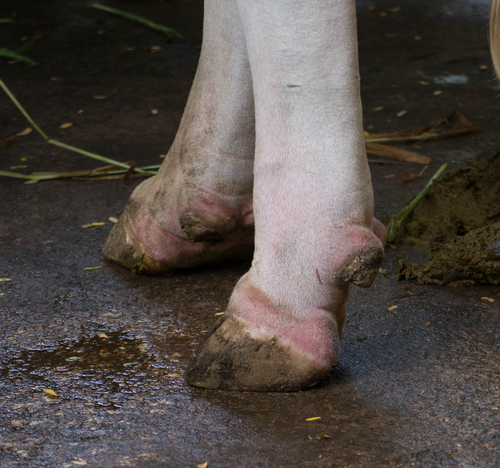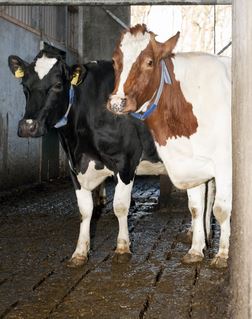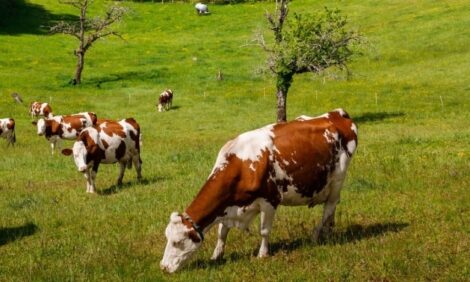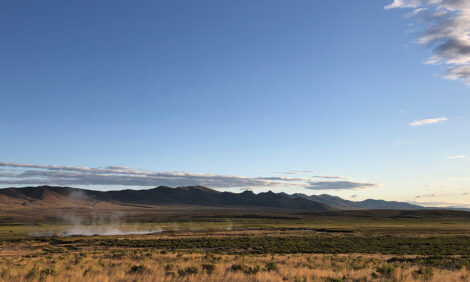



Preventing Lameness to Increase Profitability
UK - Lameness in the dairy herd is not only a significant welfare problem but can also create a significant financial loss to the farmer.It has been estimated that the minimum cost of lameness to a 100 cow dairy herd can be as much as £4,000 or €5,500.
It can lead to a loss of milk production and decreased fertility.

It can also mean poor longevity as well as increased costs in hoof trimming and unnecessary extra labour costs.
Digital Dermatitis
One of the major causes of lameness is digital dermatitis, a highly contagious, erosive infection usually affecting the skin on the bulbs of the heel but it can also be found between the digits or in the area of the coronary band.
It can affect any breed or age group, although young animals with a poor immune response are most susceptible. It spreads rapidly from newly acquired animals, or it may be introduced by any mechanical vector, such as boots or hoof trimming instruments.
Contact with slurry is one of the main reasons for the development of digital dermatitis and the disease is more prevalent in housed herds with poor hygiene and wet conditions.
Two main types of lesions are seen, one is erosive/reactive and the other is proliferative or wart-like. Both forms cause varying degrees of discomfort and may give rise to severe lameness.
Lesions vary from a few matted hairs, to loss of hair and skin damage, white keratin plugs produced on skin and scabs.
Other signs of digital dermatitis include:
- Cow appears to be shaking foot
- Cow shifts weight from one foot to another
- Walks on toes
Using Footbaths
*
"Veterinary studies have shown that regular foot-bathing is essential to hoof health."
Footbaths containing antibiotics can be used and for optimal effect, the heels of the cows should be washed thoroughly before entering the footbath.
Repeat treatments may be needed after four to six weeks, depending on the extent of the environmental challenge.
Digital dermatitis thrives in damp dirty conditions, so keeping passageways clean and minimising cow contact with slurry reduces the risk of infection.
Stock coming onto the farm should be treated by antibiotic spraying or with an antibiotic footbath and kept separated for two weeks before being footbathed again and mixed with the existing herd.
All possible hygiene measures should be taken to ensure against cross contamination such as with foot trimmers.
According to Anthony Marsh, the designer and manufacturer of the Hoofcount automatic footbaths regular, thorough footbath treatments can dramatically reduce incidence of lameness.
“Lameness is a big issue in the dairy industry and it becomes a bigger issue as yields increase as lameness can also increase,” said Mr Marsh.
“Veterinary studies have shown that regular foot-bathing is essential to hoof health.”
He said that hard concrete floors in cow sheds and dairy parlours can exacerbate the problems and he recommends foot bathing after milking.
Automated Footbath
He said that his company’s Hoofcount automatic footbath was designed to give a solution of liquid that the cow walks through to clean and disinfect the hooves.
It counts the number of cows through the bath and then after a pre-set number of cows have passed through the bath, the system empties the soiled solution, washes the bath and refills. While refilling a choice of chemical is automatically added to the solution to give a clean and effective footbath for every cow.

He said that the latest development of the Hoofcount Excel, which is being officially launched at the Livestock Event in Birmingham, has an increased length of the footbath to 3.7 metres and a 200 mm depth allowing each hoof to enter the bath an average of three times rather than as with a standard bath of maximum three metres, hooves only giving an average of two foot immersions per pass.
A further development of sloped stainless steel side sheets allows the bath to be narrower and gives a reduction in loss of solution through splashing.
He said that the estimated cost of lameness is £180 per case and improving cow health and welfare, in turn increases productivity and profitability in the dairy herd.
Vet, Dr Graham Shepherd, who is a director of G Shepherd Animal Health (GSAH) also stressed that regular foot bathing, combined with skilled foot trimming, will help to protect cattle against diseases like digital dermatitis.
“Just like mastitis, digital dermatitis is a bacterial infection and as every teat should be dipped after milking, the same is true of foot bathing,” said Mr Shepherd.
“Every hoof should be disinfected as regularly as possible, in order to reduce infection levels within the herd.
New Disinfectant
G Shepherd Animal Health is also launching a new disinfectant, designed for routine use in cattle footbaths, at the Livestock Event.
The formalin alternative, TK Everyday, contains a unique blend of disinfectants which is effective for treating foot disease, as well as being safe for use by the operator (once diluted).
“TK Everyday contains a synergistic blend of organic acids as powerful disinfectants. It also has a surfactant, which helps to increase the cleansing effect and promotes penetration of chemicals into the hoof, skin and dirt. Tea Tree oil is included as an antiseptic,” said Dr Shepherd.
“Our formulation does not include formalin, copper or quaternary ammonium salts, all of which can be undesirable. Formalin is proven to cause cancer, while copper is a potential land pollutant. Quaternary ammonium salts have been banned by some milk buyers, as the residues are thought to persist in milk.”
Producers, who use the TK Everyday Footbath, should renew the footbath contents after one cow pass for every one litre of solution, for example if your footbath contains 300 litre of solution then change it after 300 cows have been through, he adds. The solution concentrate is priced competitively, with 200 litres and 1,000 litres costing £500 and £1950 respectively. It is intended for use at a dilution of two per cent for the first week and one per cent thereafter. Cost per cow is similar to formalin.
While not carcinogenic like formalin, or asthma inducing like glutaldehyde, TK Everyday is corrosive and users should wear eye and face protection when handling the product. Free next day delivery is available on all GSAH products.
Eradication Not Just Control
Another company that has set out to combat hoof problems of cattle and sheep, and in particular Digital dermatitis, Ecohoof has embarked on a £500,000 project, backed by Scottish enterprise and in collaboration with Edinburgh University.
*
"...part of the problem with current topical treatments are that they are dealing with surface skin only"
The 18 month long project is designed to find ways by which Digital dermatitis can be eradicated and not just controlled.
The company already has a germicide footbath that is designed to replace formalin and is designed to be environmentally friendly and safe.
At the Livestock Event Ecohoof is presenting Blue Clay Shoes a paint-on type product as used by hoof trimmers/farmers after trimming.
Tom McLean from Ecohoof said: “In our opinion, part of the problem with current topical treatments are that they are dealing with surface skin only and there is no penetration or extended effect in regard to deep tissue infection which causes repeated outbreaks of symptoms.
“Blue Clay Shoes addresses all of these issues in that deep penetration of effective and persistent essential oils act on the reservoirs of infection within the hoof areas for an extended period and is not just a "quick fix". This is achieved using a powerful, but safe, blend of essential oils contained within medicinal grade carriers to quickly penetrate through the various layers of skin. This provides deep seated relief.
“Blue Clay Shoes also contains a carefully balanced blend of wetting agents and natural solvents to create a planned drying time.
“After application it forms a poultice around the hoof acting as a barrier to external ingress providing a 12 hour (approximately) contact period of bactericidal agents. After approximately 12 hours the poultice will dry and flake off and degrade into the earth leaving the penetrated oils to continue bactericidal activity for some days after. Built in moisturisers assist to maintain the skin in good supple, healthy order. Unlike other topical preparations, no bandaging is necessary.”
Hoof Trimming for Prevention, Detection, Treatment
While foot bathing is an essential part of the prevention and treatment of lameness and digital dermatitis, hoof trimming is also an important part of the prevention, detection and treatment of hoof problems.
To ease the operation for the farmer or hoof trimmer, Austrian equipment company Rosensteiner has developed hydraulic crushes that fit the animal and also simplify the work.
The Red 5 is a new catching devise that opens in its whole width of the frame, to help the treatment of all dairy and beef cattle.
It fits both big and small cows and has a front leg winch and rear leg lifting device that are activated electrically so that the hoofs are brought into a comfortable position for both men and animals quickly.
The Red Q is a tipping crush that is operated hydraulically with ease and without stress. All four hoofs stay free from dirt and can be treated simultaneously within a working area smaller than two metres.



